It’s been a few years now since I chose to give away game fishing and get right into estuary lure fishing but I quickly found that I wanted to get into bigger fish.
So about six months ago I hung up the bream gear for a while to concentrate on targeting big estuary fish.
I used the same line of thought that I had been taught in business – apply 100% or don’t do it at all.
Now this does not mean that you need a new boat, new flashy reels and a heap of new tackle. It just means focusing a little more on doing things right with the right tackle and getting the right game plan together.
Choosing the right location plays a big role if you’re going to find success regularly.
For me this meant working out the honey holes in my local waters on Lake Macquarie.
This doesn’t mean that we all need to flock to Lake Mac to tangle with the fish you see in the pictures here, but it does mean finding the similar honey holes that exist in your own waterways.
The signs I look for will also apply to your home waters, whether that’s along the NSW coast, down into Victoria or into southern Queensland – the target species are the same and so is their habitat.
The key with any form of hunting is knowing your target. I wanted Big flathead and I wanted mulloway.
These can be targeted at the same time and are found in the same locations and caught using similar methods.
Many anglers think that a big flathead has no fight, a bit a lazy heavyweight, but that’s not the case.
Cracking the code on big flathead will soon have you realising just how hard these fish can go.
And as for the mulloway, we all know they are at the top of the wish list for many anglers fishing our estuaries.
So let’s work on where to look for these great fish, the tackle and techniques used and how to make sure you increase your odds when out on the water with lures.
Where to start is often the hardest question.
A few key things to look for that are critical, regardless of which waterway you are working.
Food, in the form of baitfish, is the key ingredient.
The schools of tailor, for example, that we have in our local system mean a few things. The tailor themselves are a source of food for the mulloway and the tailor schools are usually smashing up balls of smaller fish, such as little whitebait, and it’s all these scraps falling to the bottom that have the flathead hanging around in good numbers down deep.
It is certainly no coincidence that when you find the bait schools you find the flathead and mulloway.
We have proven this time and time again and now if we fish a spot that had been producing but see no signs of baitfish and no hits on the lures after the first drift, we up and move until we find where the bait schools are again. We know our target species are always nearby.
During the cooler months we are generally looking for water of 8m-10m – deep for Lake Mac. And in the warmer months we concentrate on 3m-7m depths.
This is by no means a hard and fast rule but it does seem to be the case on most days for us.
Generally we are after some form of structure in these depths and that can be anything from an old sunken barge, a reef, rocky point or even a hole or drop-off. They are all good bait-holding areas and in turn will attract the larger predatory fish.
As for time and tides, we don’t really get as caught up in these, as some anglers do. Much has been said and written about the best times of day or the best tides but to be honest, we like to keep it simple.
The best time to catch a good fish of any type is the time that you’re on the water fishing for them.
I’m not one of those ‘up early to beat the crowds’ kinds of anglers. I like to wake up, have my morning coffee, hook the boat up and off I go.
Generally my first lure won’t even hit the water until 8.30am-9am and we can find a steady run of fish throughout the day.
With any form of lure fishing, it is really important to have a well laid-out boat with everything easy to get your hands on and not in the way.
You must be able to fish 360° around the boat also. Anything from an open tinnie to a tournament-style boat and those in between, such as my side console Polycraft, is ideal for this style of fishing.
A good quality sounder is really important for locating those bait schools and the use of a GPS will certainly make life easier for you over time, as you will start to see patterns emerge on where you get your fish.
Things such as electric motors are handy but they are not necessities.
Being quiet on approach to any fishing ground is important and I think it is extremely important if you want to be successful at this style of big-fish estuary angling.
Do not go racing through your drift line on approach to your next spot and don’t go banging things around in the boat. You don’t have to be that church mouse but do try to keep the noise to a minimum.
A lot of anglers see some of the fish that are caught and straight away think they need to go out and buy a spool of 20lb braid and 30lb leader with a 4000 size reel for these fish, but that is not the case at all.
Regardless what I am fishing for, I want it to be fun and a challenge without being ridiculous. A 2500 size reel spooled with 6lb-10lb braid is fine and 12lb-16lb fluorocarbon leader is generally going to do the job.
I don’t care what brand tackle you like to use but the rod must have a good action to absorb the head shakes and a 2kg-5kg rod around 7’ is a great choice.
The reel is the very important part here. It must have a smooth drag; if not, you’re wasting your time as these fish will run and they will run hard.
It’s not a case of ‘Ah, the line won’t pop’; the fact is the line may not pop but the hook can pull out the fish if the line doesn’t break first due to a poor drag on the reel.
There are a million lures on the market these days but if you look in the right places you will find some that certainly work better than others.
These days places like fishing forums, publications such as this magazine, Facebook and so on can all offer some great advice on what lures may or may not be the way to go.
For us there are basically three main kinds for this style of fishing for these species – soft plastics with paddle tails, soft plastics with slim minnow profiles and vibrating blades.
We look for 3”-6” soft plastics with a good action and we certainly have better luck on some colours than others.
White is a standout for us, as are light blue, green and even black at times, and when you think of what the larger fish are chasing you can understand why.
As for blades, we have our best days throwing 40mm-55mm blades in similar colours.
Jig heads are also very important. You need to ensure you have enough weight to get that lure down to the bottom. We generally use 1/2oz as a minimum.
But we switch to jigging anything up to 1oz if it’s windy and we also often use a parachute anchor to slow our drift to keep the lure in the zone longer. Trust me these are the best $30 you will spend and I honestly get more use out of this than the $1800 electric motor hanging off my bow.
There are a few methods that we use, depending on the day.
We nearly always have a rod drifting out the back with a 4”-6” lure on a 1oz jig head simply bouncing along the bottom while we are up the front casting around. You will be surprised how often a quality fish pounces on this lure.
If the winds are reasonable we will be up front casting in the direction we are drifting. This allows us to work the lure along the bottom all the way back to the boat.
If there are two anglers on board then ensure one is using a blade, for example, and one a paddletail plastic and have a slim plastic minnow drifting off the rod in the holder. You’ll find out which one is working best on the day.
We generally keep our retrieves low key with nothing too erratic but everyone has their own preferred methods.
I love the burn and kill, a fast wind then pause, fast wind then pause. Yet mates prefer the two small hops and a pause retrieve.
We find that if the wind is too strong we get better results switching to heavier jig heads and jigging our soft plastics as we drift and this method can be equally effective.
We certainly still get that odd day when nothing we do works and we may get only a fish or two but as a rule we get many more than we did in years gone by and the quality has improved considerably.
It’s nothing now to have a great session of a dozen flathead over 60cm with some of 70cm-80cm and lose count of the 40cm-60cm fish along the way.
And anglers who previously thought the only way they would get a quality fish like a mulloway would be by chance or by soaking a live bait all night will also realise they are a semi-regular catch.
You can reasonably expect to start tangling with mulloway from a few kilos through to quality 10kg-15kg fish and even up to 20kg.
Does this mean that my bream gear has been put away for good? Not a chance, but for the time being I am loving the challenge of these larger estuary fish and I’m sure you will too.
Facts
HANDLING LARGER FISH
• It is critically important that all the large female flathead are released where possible.
• Ensure you wet down your brag mats when measuring any fish.
• Invest in a good quality big landing net with a rubber net, Environet or similar.
• Lip grips are also handy but ensure you support the fish under the belly section as well.
• Lindy fish handling gloves are very useful and allow the angler to get a good jaw grip without harming the fish or angler.
• Make sure you take your pics when the fish is fresh out of the water. The colours will come up much better this way.
• Enjoy the thrill, enjoy taking the pics and enjoy releasing the fish. You will soon find releasing them is nearly as good a feeling as catching them.
• Use scent on all your lures. Just a little goes a long way and you will see the benefits.
Mulloway of this quality are what it’s all about. This is the author’s PB of 108cm and 10.5kg.

–
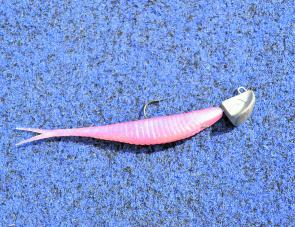
An example of a great lure ideal for this situation. A 5” Damiki Armour Shad on a 15g jig head.
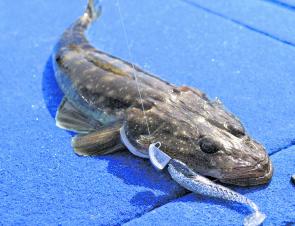
Flathead around 60cm mark are common when working lures down deep.
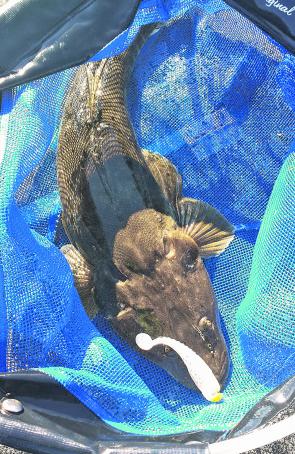
This flatty is resting nicely in a quality flathead-friendly landing net.
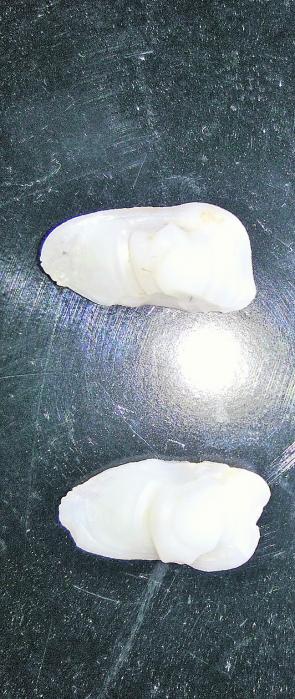
A set of mulloway ‘jewels’ or ear bones.
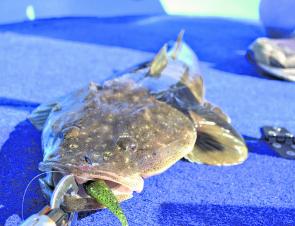
A fat 70cm fish hooked cleanly through the top jaw.
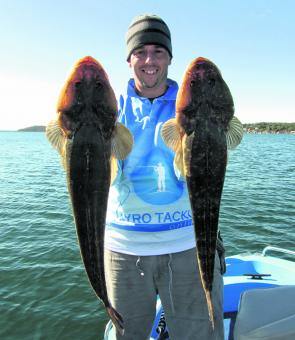
The rewards of a good session: a pair of solid 70cm-plus flathead.
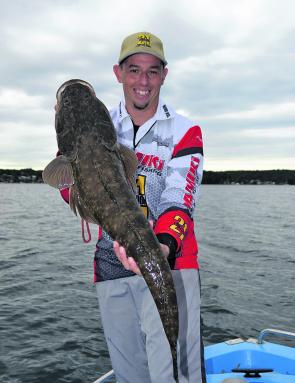
The author’s PB flathead of 85cm, taken on a 3/4oz jig head and 5” Damiki Shad jigged during a windy day on the water.
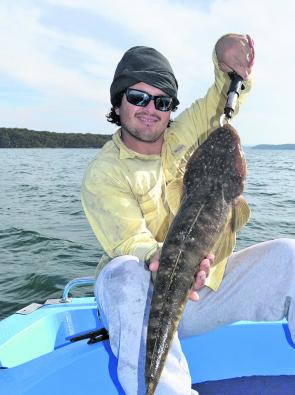
Dom Perrone with this healthy 74cm flathead, one of two crackers he released during a recent session.

This is the key. Find the bait balls and you find the target species.




